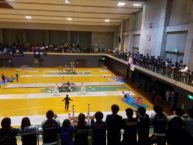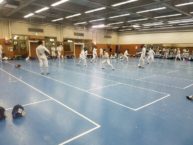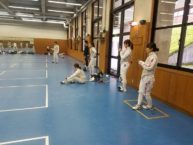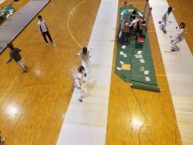This post officially marks the end of my CIP forever! It’s my second semester of CIP, with my first being a member in Doshisha’s piano circle. This semester, I’m the keyboardist for a band – called “ガールバンドパワー(GBP)” – along with Ife (vocalist), Shouko (bassist), Mako (drummer), and Noyuri (backup vocalist).We have a concert planned for the 17th of this month, for which we’re practicing a mix of Ife’s awesome songs and Japanese rock covers.
Like i mentioned in my previous blog, I really didn’t know what to expect going in; I’ve done large string orchestras before, but never small, garage “rock” bands. Or, more accurately, studio bands since that’s what we rent and practice in. We started off at the nicer but pricey Studio 246 (where out concert will be held) in Shijo, but recently switched to the much smaller but cheaper Studio BURU. Studio BURU is only a 2-minute walk, literally across the street behind the Ryosinkan, and a single person practice room is only 500yen per hour, so I highly recommend it if you’re looking to practice piano (which I do), drums, or any other instrument that catches your interest! We planned to meet every week for an hour, but due to time conflicts, sometimes 2 or 3-hour makeup sessions happen.
As for the practice sessions themselves, they went surprisingly well. They’re a far cry from the stereotypical image of a drama-filled, crazy rock band, which I think is due to the combination of the Japanese members’ easygoing natures, other members’ past band experience, and Ife’s encouraging leadership. Ife dances around and tells us to let loose, but we tend to smile and laugh quietly; me because I’m nervous and the others, I assume, because they have more reserved natures characteristic of many Japanese people. I feel comfortable around everyone, but, just like in piano circle, I don’t feel particularly close to the Japanese members. Seeing Shoko in the hall today was the first time I’ve seen anyone outside of band practice, where we talk about the music 95% of the time. Although I spend more time with them than last semester’s piano circle members, I think it still requires more effort – LINEing regularly, inviting the Japanese person to activities – to become what they consider a friend, as opposed to more easy invitations in the US.
A key difference from piano circle is that I haven’t noticed the senpai-kohai relationship present. I’m not quite sure what year everyone is in and they’ve never asked me for mine, a question that I always got after meeting someone new in piano circle. Since the Japanese members were separate acquaintances of Ife, I’m not sure if the Japanese members know each other’s years in the band. But they’ve been speaking casually to each other from the start, so I assume it’s not as important in a small, less formal group. Just last week, when Noyuri came for the first time, despite initial introductions being in distal (-desu/-masu) form, Mako soon switched over to casual speech. Perhaps being in a band automatically creates what is, technically, an “in-group” of sorts? The lack of senpai-kohai relationships in the band makes me more comfortable interacting with everyone since I don’t have to worry about not fitting into that construct as a third year international student. Last semester in piano circle, I was stuck between being a senpai and a kohai: I’m a third year, but I’m also a study abroad student who’s never participated before in piano (or any) circle.
Overall, this semester I have learned less new aspects of Japanese culture than I have fleshed out what I learned last semester. I joined piano circle last semester purposely to get a feel of Japanese circle and club interactions. But after stressing each week over how to act and where I’d fit in during club activities (being the only third year who did yobikomu during the school festival, while the rest of the upperclassman organized scheduling and made food), I wanted to try the opposite: spending time with a small group of Japanese students in a casual setting. Depending on your personality and/or your goals, my recommendation for a CIP activity would vary. I highly recommend smaller, not as school-affiliated groups if you’re like me, generally more reserved and would like to have a constant few faces rather than often shuffling circle acquaintances. On the other hand, trying circles and clubs are truly a great way to experience a unique and very prominent component of Japanese university life. The circle culture is much stronger than that of clubs in the US and introduces you to students not particularly interested in English/international affairs. To hear more about my experiences last semester, please read that blog post here.




